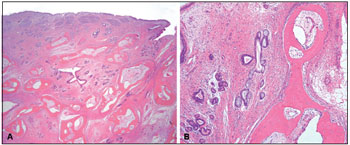RESEARCH
Chondro-osseous respiratory epithelial adenomatoid hamartoma of the nasal cavity
Original Link: ncbi.nlm.nih.gov/pmc/articles/PMC4423336 April 17 2013 print
Hamartomas of the head and neck generally, as well as the sinonasal tract specifically, are very rare. They often consist of mesenchyme and may rarely include epithelial elements. Respiratory epithelial adenomatoid hamartoma (REAH) and chondro-osseous respiratory epithelial adenomatoid hamartoma (COREAH) are examples of hamartomas comprising both epithelial and mesenchymal components. Although invariably benign, these lesions may grow to relatively large sizes and pose clinical concerns. We report herein what represents, to the best of our knowledge, the third case of COREAH of the nasal cavity, emphasizing its clinicopathologic features and the importance of recognizing and differentiating it from other, potentially more aggressive lesions of the nasopharynx.
A healthy 38 year-old woman presented to our institution with a left nasal mass that was discovered on a computed tomography (CT) scan performed at an outside hospital. She had complained of mild left nasal obstruction of a few months’ duration; however, no epistaxis, rhinorrhea, or hyposmia was reported. A punch biopsy obtained at the referring institution was interpreted as benign respiratory epithelium (slides not reviewed).
The CT scan was repeated and confirmed the presence of a 4.0x2.4x1.1-cm soft tissue mass with calcification located in the posterior aspect of the left nasal cavity. The mass abutted the lateral wall of the cavity, extending into the left sphenopalatine foramen and the left ethmoid air cells, and protruded into the nasopharynx posteriorly (Figure 1). No associated bone erosion was seen. Endoscopic examination revealed a lobulated, wellcircumscribed, smooth, tan-white polypoid lesion occupying most of the left nasal cavity. The lesion was not attached to any structure inside the nasal cavity proper, but its posterior aspect was minimally attached to the lateral nasopharyngeal wall. Endoscopic surgery was performed, and the mass was removed completely.

The submitted specimen measured 4.0x2.3x1.1 cm, had a tan, smooth outer surface, and was accompanied by multiple small irregular fragments of soft and bony tissue. The mass was hard and polypoid with a homogenous tan-white cut surface. Microscopic sections exhibited respiratory-type epithelium with underlying submucosal glands, hypocellular fibromyxoid stroma, and mature bone. The submucosal glands were irregular and exhibited focal mucinous metaplasia, but no significant thickening of the basement membrane was seen. The gland lumens were filled with mucoid material. Scattered chronic inflammatory cells were noted throughout the lesion. There was no evidence of atypia.
Hamartoma is defined as a mass-forming aberrant organization of specialized cellular components indigenous to a particular body site (1). It does not clearly represent a neoplastic or an inflammatory process or have the capacity for continuous unimpeded growth (2). Hamartomas have rarely been reported to arise in the sinonasal region. Until the early 1990s, the majority of the sinonasal hamartomas were reported to be mesenchymal, most frequently vascular, in origin (3). However, epithelial hamartomas, namely REAHs, have since been more frequently reported (2,4-6). REAH was originally described in 1995 by Wenig and Heffner, who included in their series 1 case containing mixed epithelial and mesenchymal elements with osseous metaplasia (2)...

